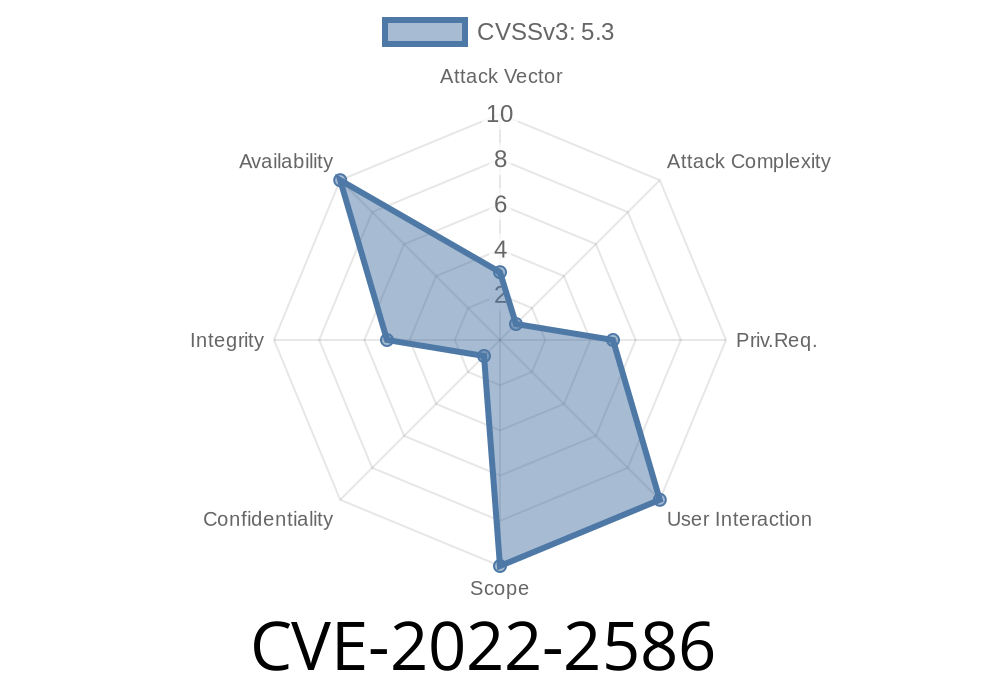The cybersecurity world is constantly evolving, and with new advancements come new vulnerabilities. One such recently discovered issue is CVE-2022-2586, a vulnerability affecting the Linux kernel's Netfilter subsystem. This vulnerability enables attackers to exploit a use-after-free condition in nft (Netfilter) tables, potentially leading to serious consequences such as denial of service, memory corruption, or even arbitrary code execution.
In this long-read post, we'll cover the details of CVE-2022-2586, provide code snippets, delve into the exploit, and discuss its potential impact. We’ll also share links to original references for further reading.
Vulnerability Details
CVE-2022-2586 affects the nftables framework, an essential part of the Linux kernel's Netfilter subsystem. Nftables allows for configuring various packet filtering and classification rules, ensuring secure and efficient network traffic management.
The vulnerability resides in the way nft objects or expressions reference nft sets within different nft tables. This can lead to a use-after-free condition when a table is deleted, resulting in memory corruption or other undesirable outcomes.
Original References
1. Nftables official documentation: https://wiki.nftables.org
2. CVE-2022-2586 original advisory: https://cve.mitre.org/cgi-bin/cvename.cgi?name=CVE-2022-2586
3. Linux kernel source code: https://github.com/torvalds/linux
Code Snippet Illustrating the Vulnerability
The following code snippet demonstrates the vulnerable function call, leading to a use-after-free scenario:
/* Vulnerable Function in nft_set.c */
int nft_set_lookup_global(struct nft_set *set)
{
struct nft_table *table;
int ret = -EINVAL;
rcu_read_lock();
list_for_each_entry_rcu(table, &net->nft.tables, list) {
ret = nft_set_lookup_byhandle(table, handle, genmask);
if (ret != -ENOENT)
break;
}
rcu_read_unlock();
return ret;
}
/* Potential Exploit Code */
// Create a new set in table1
nft add set table1 myset {type ipv4_addr; flags interval;}
// Add a rule to table2 referencing the set in table1
nft add rule table2 prerouting ip saddr @myset counter
// Delete table1 (and its set), causing a use-after-free condition
nft delete table table1
In the example above, the vulnerability is triggered when a rule from table2 references a set from table1. Once table1 and its set are deleted, subsequent traffic processed by table2's rule will reference the now-deleted and freed memory, leading to a use-after-free condition.
Exploiting CVE-2022-2586
Successful exploitation of this vulnerability depends on various factors, such as the target system's memory layout and how it manages memory. By carefully crafting an exploit, an attacker may be able to control the contents of the freed memory and potentially execute arbitrary code.
To exploit the vulnerability, an attacker must have write access to the affected system's network packet filtering rules. This usually requires root or administrative privileges. If an attacker has such privileges, they can potentially escalate their access by exploiting the use-after-free condition.
It is important to note that this vulnerability is not remotely exploitable without prior access to the target system.
Mitigation and Conclusion
Given the potential severity of this vulnerability, updating the affected Linux kernel is the recommended course of action. Patches addressing CVE-2022-2586 have been released, and users should apply them as soon as possible.
Understanding vulnerabilities like CVE-2022-2586 is essential for ensuring the security and stability of our systems. As we have seen, even seemingly innocuous issues can lead to serious consequences if not properly addressed. Stay informed, stay proactive, and stay secure.
Timeline
Published on: 01/08/2024 18:15:44 UTC
Last modified on: 01/08/2024 19:05:05 UTC
